July 16, 2025 | 13:41 GMT +7
July 16, 2025 | 13:41 GMT +7
Hotline: 0913.378.918
July 16, 2025 | 13:41 GMT +7
Hotline: 0913.378.918
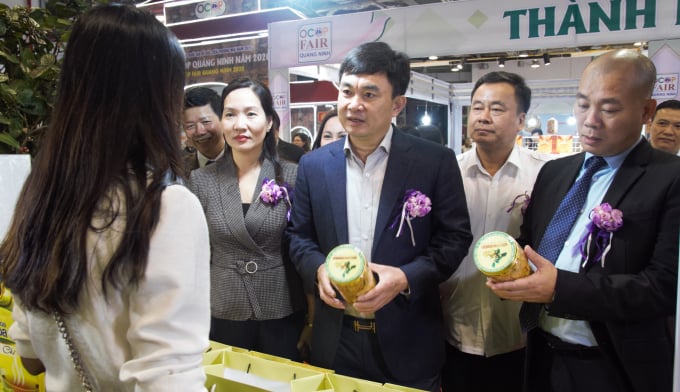
Leaders of Quang Ninh province visit a booth displaying herbal medicine in the One Commune One Product (OCOP) program. These products have been exported to Japan. Photo: Anh Thang.
Ba Che district in the province is famous for its medicinal herbs. Up to 30 out of 1,027 species recorded in the locality have high economic value namely ba kich (morinda officinalis), tra hoa vang ( Camellia Chrysantha), nam lim xanh (Ganoderma lucidum ) and ha thu o do (Radix of Fallopia multiflora).
Hoanh Bo mountain district in the northern province of Quang Ninh is famous for its medicinal herbs, a specialty of the Dao ethnic minority people. Local people have worked hard to make Quang Ninh one of the centers of medicinal herbs in Vietnam.
For thousands of years, people of Ba Che have collected precious herbal plants from the wild such as morinda officinalis, Camellia Chrysantha and Ganoderma lucidum for usage and sale on the domestic market. However, the production of medicinal plants in the district was mainly conducted on a household scale.
Due to increasing demand for medicinal herbs, supporting policies and a big market consumption, the area of medicinal plants has increased rapidly.
Ba Che district now has 243ha of medicinal herbs. Camellia Chrysantha accounted for the largest cultivation area with 146ha, followed by purple morinda officinalis with 75ha.
According to Vi Thanh Vinh, head of the district’s Agricultural Division said the production of herbal medicine of ethnic minorities in the areas is on a small scale and spontaneous. There is no linkage between the production and consumption of the products.
“It is the customs and habit of exploiting medicinal plants without long-term calculation, seriously affecting the diversity and sustainability of the plants,” he said.
Therefore, investment in pharmaceutical processing technology was important to ensure the quality of medicinal herbs on sale in the market.
Attention should be paid to the post-harvest process to ensure the active ingredient content in medicinal herbs, Vinh said.
The district has only one cooperative specializing in producing morinda officianalis and Ganoderma lucidum wine, a private enterprise engaging in purchasing and processing Camellia Chrysantha. It also has a cooperative group engaged in Dao herbal bath but there isn’t any unit taking charge of processing complete medicinal herbs. As the medicinal plants are processed manually, their quality might be affected.
To deal with the issue, since 2015, Ba Che district has built a center for nursery and processing of Camellia Chrysantha at Dap Thanh Commune. Dap Thanh Forest Production Joint Stock Company is assigned to manage the nursery garden and tea processing factory.
Each year the company supplies over 80,000 Camellia Chrysantha seedings of all kinds, processing 15.5 tonnes of fresh tea leaves and 1.5 tonnes of fresh camellia. The district authority also applies special mechanisms and policies for businesses, cooperatives, individuals, and households that have to pour investment in medicinal herb development and processing.
The district has signed a memorandum of understanding with such businesses as MEDIPLANTEX Central Pharmaceutical Joint Stock Company for cooperation in the cultivation, processing, consuming products, and investing in medicinal plant growing areas of 200 hectares in line with World Health Organisation guidelines on good agricultural and collection practice (GACP-WHO).
To have high-quality and high-value herbal medicines, Quang Ninh Province has supported the people and localities with favorable natural conditions to cultivate the plants following the Government guidelines.
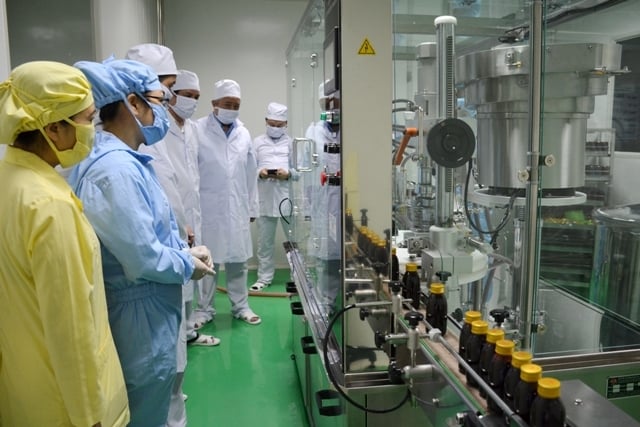
A pharmaceutical production line from medicinal herbs of Quang Ninh Pharmaceutical and Medical Material Joint Stock Company which has met the GMP-WHO standard. Photo: Ba Che Healthcare Centre.
Considering the linkage between agricultural and pharmaceutical cooperatives as key to expand production and build a global value chain for material areas and enterprises, a union was set up in late 2019. After two years of establishment, Quang Ninh Union of Agricultural and Pharmaceutical Cooperative has promoted its roles, facilitating members in the production process and businesses through a well-organized production scale.
Le Van Ha, director-general of the Quang Ninh Union of Agricultural and Pharmaceutical Cooperative, said the union has collaborated with Food Industry Institute under the Ministry of Industry and Trade and Sachalnchi Vietnam JSC in producing nearly 20 products from sachi, hibiscus, and Chùm ngây ( Moringa Oleifera) trees.
The alignment of agricultural pharmaceutical development cooperatives has contributed to promoting synergy, helping members to expand production and increase competitiveness. It has created stable jobs for people in rural areas as well as contributed to the poverty alleviation, economic development, social security, and environmental protection of the region.
In the future, the union will continue to invest in high-quality products and apply the fourth Industrial Revolution’s technologies to achieve sustainable production, meeting the market demand on agricultural and pharmaceutical products and towards export to overseas markets, he said.
Translated by Mai Hien
/2025/07/15/1941-2-221156_315.jpg)
(VAN) Over USD 8 million from the ERPA source disbursed in Thanh Hoa has created a driving force for local people and residential communities to protect and sustainably develop forests.
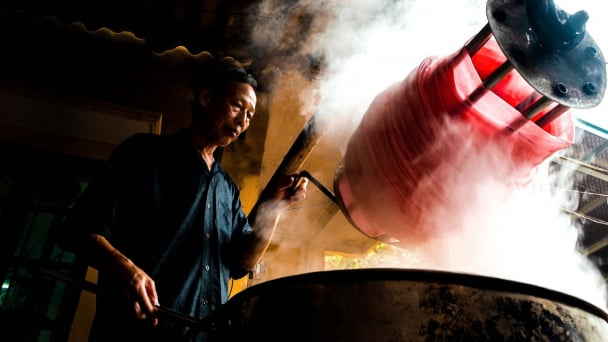
(VAN) OCOP aims to unlock the unique potential and advantages of each rural region, and above all, fosters community spirit to create multidimensional value for its products.
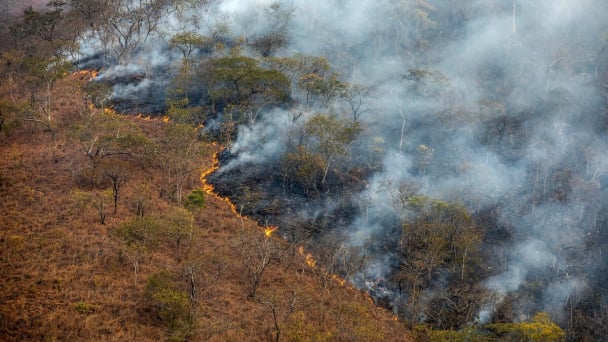
(VAN) Funding following G7 Kananaskis Wildfire Charter to enhance global collaboration for integrated fire management.
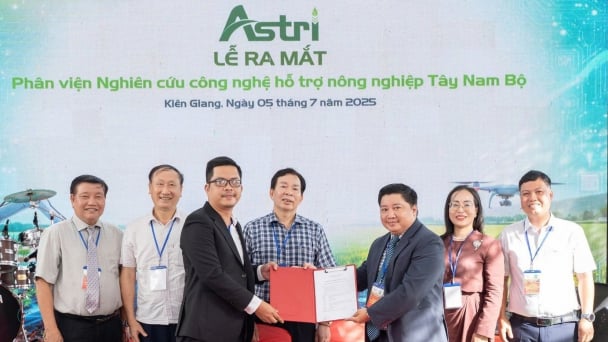
(VAN) Astri Institute launches its Southwestern Branch in An Giang, aiming to promote smart, sustainable agriculture and advance carbon credit development in the Mekong Delta.
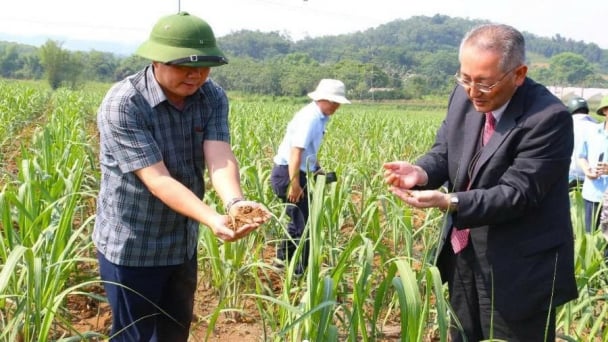
(VAN) The project not only enhances the sustainability and credibility of the Lam Son sugarcane value chain but also opens up opportunities to access global carbon financial resources.
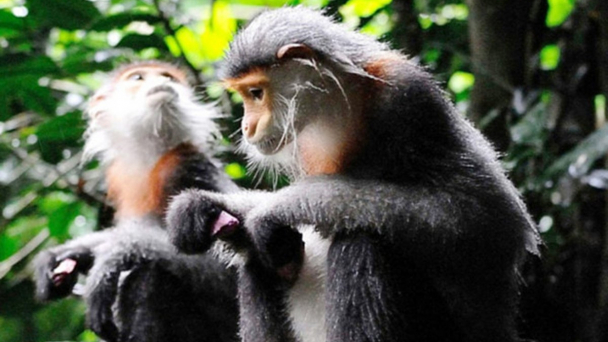
(VAN) Hanoi implements a project to strengthen regional linkages and promote the sustainable exploitation and use of biodiversity resources in protected areas and natural heritage sites in the Red River Delta region.
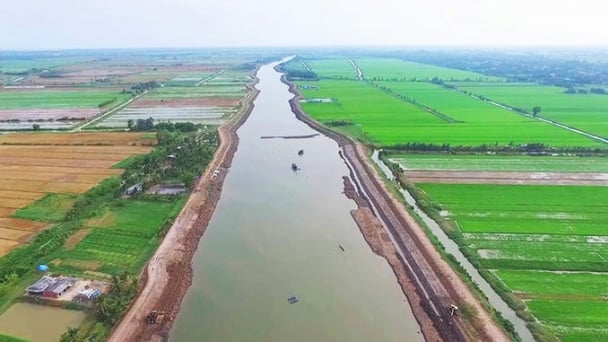
(VAN) Alternate wetting and drying irrigation in rice cultivation contributes to realizing the goal of sustainable, low-emission production under the One Million Hectares of High-Quality Rice project.